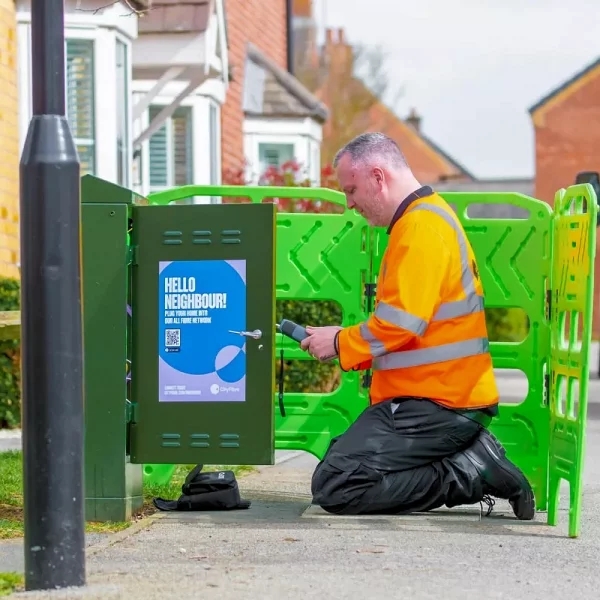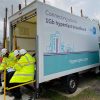CityFibre Target 850k UK Homes Covered by Full Fibre Altnets for Consolidation

A new research note from James Ratzer at New Street Research has claimed that CityFibre, which have already deployed their full fibre broadband (FTTP) ISP network to cover 4.3 million UK premises (4.1m RFS), is making progress on their plans for future consolidation and already has “up to” 850,000 homes served by other alternative networks “under M&A exclusivity“.
Just to recap. CityFibre currently still aspires to cover up to 8 million UK premises with their new full fibre network – representing c.30% of the UK. But their original target of hitting that by around 2025 will not be achieved, and the operator has instead indicated a desire to boost their growth via M&A (mergers and acquisition) of smaller alternative networks.
Not unlike other network operators in this market, CityFibre has faced pressures from high interest rates, rising build costs and competition. The operator has also scaled-back their focus on new commercial fibre build, albeit partly to help deliver on the nine rural-focused Project Gigabit contracts – worth more than £865m (state aid) – that they’ve secured from the government (in total these could help them to reach another 1.3m premises).
Advertisement
Despite this, CityFibre is currently reported to be closing in on a £500m equity financing deal with existing investors (here), while at the same time the new research note indicates that they’re also looking for around £1bn of incremental debt funding – potentially enough liquidity to keep them fuelled through to mid-2027. But much of this is more in service of funding their plans for future consolidation.
CityFibre’s consolidation drive has so far only been able to add a single altnet, LitFibre, since early 2024 (here) – reflecting an increase of around 300,000 premises. According to James Ratzer, in 2025 and beyond, it’s expected that CityFibre will likely only build out c.300k homes per annum organically, largely to fulfil their Project Gigabit contracts. But the operator still aspires to add around 1 million premises each year, which suggest c.700,000 will be coming from future M&A deals (last year they added 900k homes to their footprint, with nearly 300k via the LitFibre M&A).
The research note then indicates that, following their discussions with CityFibre, they now “understand that currently up to 850k FTTH altnet homes in the UK are under M&A exclusivity with CityFibre” (excluding the earlier LitFibre deal). This reflects M&A deals that CityFibre are in the process of trying to finalise, which are expected to follow the same sort of share-based acquisition as the LitFibre agreement.
The analyst sees all this as representing a “new, significant and very rational pivot in their business model”, which they say would see CityFibre taking “an active role in trying to consolidate the market and to prevent further overbuilding in the UK“.
Advertisement
The potential catch in all this, according to the note, is that the operator’s “strategy pivot is as yet unproven.” For example, it remains unclear how much competition CityFibre might face from rival altnets, some of which may be able to offer a more attractive deal for specific networks. Similarly, it’s unclear how willing the sellers might be to accept Cityfibre equity and then there’s the question of debt.
“The UK fibre challenger sector is carrying too much debt and we wouldn’t expect lenders will want to take a write down on their debt holdings. We therefore assume that for each M&A deal, Cityfibre has to take on £300 of net debt / home acquired. While this doesn’t increase Cityfibre’s immediate funding needs, it does increase their interest costs and might be an issue for future debt covenants as it would increase headline net debt,” warned the note.
However, despite those challenges, New Street Research still sees growth through M&A as being a “far more sensible approach to scaling Cityfibre’s business than continuing with excessive levels of organic network build“. The key takeaway for now is that CityFibre’s investors seem to have confidence in their approach, at least for the next few years, and appear ready to support their consolidation drive. Time will tell.
Mark is a professional technology writer, IT consultant and computer engineer from Dorset (England), he also founded ISPreview in 1999 and enjoys analysing the latest telecoms and broadband developments. Find me on X (Twitter), Mastodon, Facebook, BlueSky, Threads.net and Linkedin.
« Hope for Broadband and Mobile Boost as UK Gov to Publish Planning Bill























































Would be more achievable if they didn’t make it available to half a street and call it a day like they seem to!
Parents house is sadly on the pact of the street that can’t get CF
So that’s where the missing 4 million premises are, on the other side of the street!
@Andrew,
My mum has the same, CF installed to all other houses on the same street (1980’s estate), apart from the offshoot cul-d-sac of 6 houses, same street name/postcode, just built straight past it.
That is the problem, but this sort of thing have been happening for years, even before this rush for Fibre started. My nephew lived in a street where one side had Virgin and his side did not, this was before Openreach started to roll out FTTP.
i know of other people who have the same sort of problem.
I had something similar happen to me with what was then known as Telewest. They cabled up the other side of the street in the late 1990s, but didn’t do our side until about 3 or 4 years later.
Cityfibre repeatedly claimed they were ‘fully funded’ to build covering 8 million premises. Now at just over 4 million premises we keep hearing they’re looking for more money.
That’s not just a small miscalculation that can be blamed on higher interest rates, unexpected competition, etc. What’s really going on?
I’m pretty glad I don’t have to work at CF alongside you. We doing just fine thanks
” The key takeaway for now is that CityFibre’s investors seem to have confidence in their approach, at least for the next few years, and appear ready to support their consolidation drive.”
Bet you hate that, don’t you DF!
Cityfibre also claimed that 2024 was their first full year of profitability, of course everyone knows that’s not true.
@Facts – Your quote missed out the very important final three words “Time will tell”.
@DF – That’s a yes then.
@Robert
Cityfibre made £5m EDITDA. The first 3 letters stand for earnings before interest. In accounting terms earnings = profit. So they are 100% correct in what they said. If you agree or not is irrelevant, they are 100% factually correct.
@facts:
The EBITDA excludes the costs of servicing the debt. Given that the business is growing its revenue but is highly dependent on debt financing to achieve its objectives, the EBITDA does not give an accurate picture of the business.
@Facts – To avoid misinformation I’d like to make it clear EBITDA is not equivalent to profit.
It doesn’t matter how you try to spin it, EBITDA is not profit and should not be announced as profit, it is purely a measure of a company’s operating performance.
It’s very simple, profit is the amount of money a company earns after all expenses have been deducted from its revenue.
Tell me you’re not an accountant without telling me you’re not an accountant….
@Anon:
You cannot safely take an interest in business and invest in them if you donot understand the terminology.
Didn’t you claim that ‘earnings’ meant ‘revenue’ in an earlier comment here?
I’m not an expert in accounting and clearly neither are you else you wouldn’t be writing this and wouldn’t have worked in marketing for CF. Probably smart to stop writing comments on it.
Just FYI operating profit/loss includes depreciation and amortisation. EBITDA, it’s in the acronym, doesn’t. Accounting is boring and often not intuitive but the key terms are well defined.
Is using EBITDA as a claim to be profitable potentially misleading to non-accountants? Sure. Is it a total fib? No, but could absolutely be said they shouldn’t claim profitability without caveating that they are EBITDA positive not net profitable or cash flow positive.
Let’s not do amateur accounting here, eh? It’s a rabbit hole.
To Facts: So by your logic, if I bought a car for £1,000, spent £500 repairing it then sold it for £1,100 I made £100 profit?
I’m glad you don’t do my accounts!
No. EBITDA overs operating costs. So in your example you make a EBITDA of £400 loss.
Robert: please go Google EBITDA. Costs of buying and income from selling are the basis of business.
EBITDA would be relevant if you bought the vehicle on credit, bought equipment to refurbish it, and then sold it after a while. The EBITDA number would exclude your amortisation of the equipment you bought to refurbish, the depreciation of that equipment and the interest you paid on the credit. The clue is in the acronym. Networks are really capital and plant intensive so depreciation and amortisation are a big thing. A wholesale cash and carry type place not so much. They’ll have few fixed assets to amortise and deprecate relative to their flows.
its amazing how short sighted people are, our 2 national incumbents are bt and vm, both of which took years to establish and in vm,s case also to merge and consolidate the market, cf have kick started a fibre drive in the uk, something neither incumbent really cared about , they sold us all products called fibre that weren’t fibre for years,the fact is the market is saturated with altnets and needs consolidated , once consolidated there will be a huge fight for customers and its a fact cf will offer best product best price , will everyone be able to get it , no, but those who will will be grateful, they will see how taken advantage of we where as consumers for years,cf to fully grow will need every penny of its debt, every penny of additional funding but it will grow ,cf is fully funde , timescales is something that definitly has been hampered in recent years , building there own network to 8m just wont happen in timescale but it is fully funded, what people need to ask themselves is what do they need the additional funding for, big things i would imagine
There is so much here that’s wrong.
They aren’t fully funded to 8 million and know it. Not even close. If they were fully funded they wouldn’t be seeking more funding at barely 50% complete and anyone can read their fillings at Companies House.
The additional funding both equity and a new debt raise on top of any unused facilities isn’t for fantastic new things it’s to keep the lights on while they do the Project Gigabit builds, the Public Services Network stuff and some Fibre Cities build and hope to reach cash flow positive.
You mentioned VM. In case you missed it ntl went into chapter 11 bankruptcy protection and both ntl and Telewest almost entirely wiped out their equity holders in debt for equity swaps. CityFibre has spent an insane amount of capital per premises so far and needs additional funding and interest rates to go the right way when they have to refinance.
Building a business through acquisitions can of itself be a very expensive way to grow, with many hidden costs that are typically not identified until after the merger has been signed-off. Mergers can also take between 18 months and two years to complete and usually fail to deliver the intended outcome.
An average take up of less than 20pc. That is very low. Their older deployments will have a higher take-up but it still seems to be a long way from where investors would probably want it.
It doesn’t matter how big the footprint is at this point, it matters what the penetration rate is. Time is against them, people tend not to switch that often, cityfibre could end up with a big footprint, but customers locked into 2/3 contracts already. Sky will help, but will take a year+ to onboard.
Sky will be onboarded before the summer is out.
@Bob Seager; But you didn’t say which summer.
We’re fully funded to pass 8 million premises.
We’ll pass 8 million premises by the end of 2025.
2024 was the first full year of profit.
I’m sure you can appreciate it’s becoming difficult to trust anything Cityfibre says.
You say it’s difficult to trust CF. Well bit like BT then, that their symmetric service coming out is so ridiculously overpriced that they don’t have any real intention of launching it, and the small trial of xgs-pon later this year in the hope people will sign to BT to wait for it to come, whilst BT hope the altners go broke so they don’t ever have to deliver it.
The hate for CF from BT shareholders is something to behold
CityFibre is in a difficult position – as are many of the AltNets and perhaps more than one of the majors. That is not coming from shareholders of any of the three networks; this is coming from the analysts. They are claiming that CityFibre will run out of cash this summer without the additional funding. They are predicting that the backers will take a hit. They are stating that take-up of the full fibre network does not meet the company’s own expectations, let alone those of the market and investors.
Agreed. Many BT fans or shareholders on here.
Personally, I hope the ALTNETS kick their backsides. Without them, Bt would have kept us on fttc a lot longer. Even their fttp deployment is legacy GPON whilst most Altnets ahead with xgs-pon and symmetric speeds.
@anonymous:
There may well be BT shareholders posting comments here, but there are far more bitter people posting invective that in variable blames BT for everything.
I am with an AltNet but will jump back when Openreach actually get around to cabling up the street, at least I will have a choice of provider.
It seems weird to me that altnets put in their own equipment etc, whereas in the old days everyone piggied on the same cables.
Openreach will likely be planning to scale back their own roll-out plans as well, given the change in of cost factors since the general election.
Unless you have a bad altnet, why on earth would you do that? Go from a keen priced symmetric service to a legacy GPON asymmetric service that is likely more money with in contract price increases every year and recontracting customers can’t get new customer pricing? I agree that only Netomnia does the latter at the moment, but other altnets likely to follow.
@anonymous:
Once there debt-driven funding dries up, the AltNets will have to shift to a commercial price structure.
How will this ‘prevent further overbuilding in the UK’ as currently most overbuilding is being done by BT/Openreach and Nexfibre.
Most seem to be cutting back on builds, and it is market shake-out time, so a large number of the players are likely to disappear soon, the overbuild will come to a halt, and the government will have to reassess the value for money of the BDUK scheme.
When there are 3 full fibre suppliers in the same area at least 1 will end up with less than 33% coverage,
Article in The Telegraph:- https://www.telegraph.co.uk/business/2025/03/11/cityfibre-break-bt-broadband-stranglehold-struggled/